

| Home | Log In | Register | Our Services | My Account | Contact | Help |
You are NOT currently logged in
dai oldenrich - 01 Sep 2006 13:32
click your browser refresh button to update charts
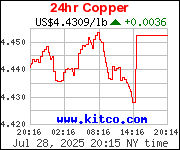
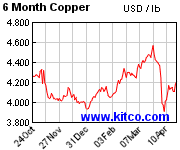
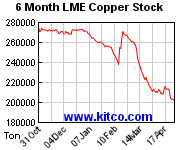
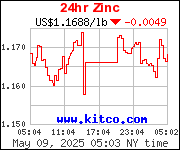
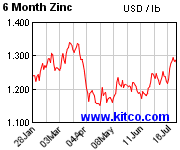
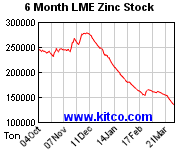
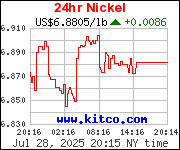
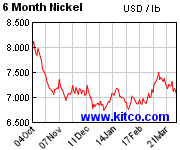
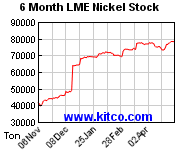
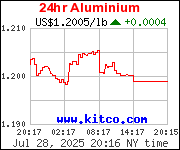
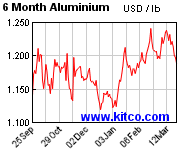
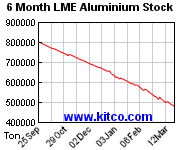
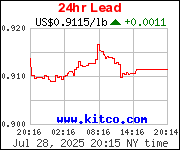
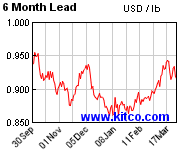
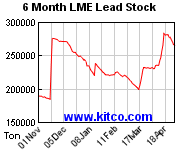
Also see: gold charts here silver charts here platinum charts here
dai oldenrich - 08 Sep 2006 06:43 - 26 of 181
Sept. 8 (Bloomberg)
The price of copper used to make wires and pipes may resume rising as output disruptions may cut supply, he said.
Workers at BHP Billiton Ltd.'s Spence copper mine in Chile are expected to vote Sept. 15 to strike. An almost four-week stoppage at BHP's Escondida mine in Chile that cut copper output by about 45,000 tons ended Sept. 2.
A strike at Spence will postpone the start of copper production at the mine, scheduled for October, Andres Ramirez, president of the union at Spence, said yesterday from the Chilean city of Antofagasta.
dai oldenrich - 08 Sep 2006 07:17 - 27 of 181
BHP Billiton's Union at Spence Expects to Reject Wage Offer
By Heather Walsh
(Bloomberg) -- BHP Billiton's union at its Spence copper mine in Chile expects to vote next week to strike, saying that the company refuses to meet its demands for wage increases.
The union plans to vote on Sept. 15 to reject a company wage offer to increase salaries to keep pace with inflation, said Andres Ramirez, president of the union, which wants salaries to rise by 7 percentage points above inflation.
``We aren't asking for anything out of this world,'' Ramirez said in an interview from the Chilean city of Antofagasta. ``They are pushing us to a strike.''
A strike would postpone the start of copper production at the mine, scheduled for October, Ramirez said. The wage dispute would be the second this month in Chile for BHP Billiton, the world's largest mining company. A union at Escondida, the world's biggest copper mine, returned to work Sept. 2 following an almost four-week strike that halved the mine's output and led to a loss of about 45,000 metric tons of copper production.
Mauro Valdes, a spokesman for BHP Billiton in Santiago, today declined to comment on whether a strike at Spence would postpone production.
Workers at Spence earn on average between 350,000 pesos ($647) and 400,000 pesos per month, less than the average for Chilean miners, Ramirez said. He said workers also want to the company to share its profit after prices for copper jumped 70 percent this year.
BHP Billiton, along with Codelco, the world's biggest copper supplier, and Falconbridge Ltd. will negotiate additional wage packages this year or in 2007 with unions at mines in Chile. The country produces 36 percent of the world's copper.
dai oldenrich - 08 Sep 2006 07:19 - 28 of 181
Engineering News
Miner predicts big zinc shortfall
ASX-listed Mount Burgess Mining said that world zinc output would have to grow by 22% on this year's production estimate of 10,6-million tons to meet expected demand by 2010.
Speaking an African-focused mining conference in Perth, on Thursday, chairperson Nigel Forrester said that new mine start-ups, production upgrades and mine closures would have to fill the expected shortfall of 2,38-million tons.
He said that China would remain the driver for higher zinc production globally.
"If China increases consumption by an average 345 000 t/y to 4,8-million tons total by 2010, and the rest of the world increases consumption by a modest 2%, total world production within three years must reach 13-million tonnes," Forrester said.
Forrester said that stocks and output would be at critical levels by early in 2008.
"The decline has been evident over recent years with London Metals Exchange stocks of 780 000 tons in April 2004 dwindling 606 500 tons in just 27 months to 173 500 tons by just a few weeks ago."
He said it represented an average daily decrease of 728 t/d over the 27 months and that it would worsen to 907 t/d this year.
dai oldenrich - 08 Sep 2006 07:21 - 29 of 181
Dow Jones Newswires - Friday, September 08, 2006
Copper May Rise On Restocking, Strikes - World Bank
0115 GMT [Dow Jones] Copper prices could rise on reemergence of strong Chinese demand after now-complete period of de-stocking, says World Bank in monthly commodity review. Notes global stocks of red metal remain critically low and after 25-day strike at world's largest copper mine, Escondida in Chile, "other labor contracts in Chile and Canada expire this year which could prop up prices." LME 3-month copper last at $8,030/ton, up $20 vs London PM. (JAD)
dai oldenrich - 09 Sep 2006 06:35 - 30 of 181
8 Sept 2006 - Bloomberg - By Chanyaporn Chanjaroen and Dale Crofts
Mine Strikes
A decline in copper prices may be limited by speculation that unionized workers at BHP Billiton Ltd.'s Spence mine in Chile will strike next week, cutting supply.
Workers will probably vote in favor of a stoppage on Sept. 15 to demand higher wages, Andres Ramirez, president of the union, said yesterday in Antofagasta, Chile. A 25-day strike at BHP's Escondida mine in Chile cut output in half at the world's largest copper mine. The walkout ended Sept. 2.
A strike at Spence ``would add to the tightness in copper,'' Neil Buxton, managing director of London-based GFMS Metals Consulting Ltd., said today by phone. Strikes are ``a reason why copper prices will stay at high levels.''
Eight of 16 analysts, investors, traders and consumers surveyed by Bloomberg News today forecast copper will rise next week for a fourth consecutive week. Four expected a drop and four predicted little change.
Copper stockpiles monitored by the LME fell 2,525 tons, or 2 percent, to 125,150 tons, the exchange said. That's less than three days of global consumption.
``Copper is still pretty well supported,'' said Donald Selkin, director of equity research at Joseph Stevens & Co. in New York. ``There is some tightness.''
dai oldenrich - 09 Sep 2006 06:36 - 31 of 181
Source: AFP - September 9
BHP faces second Chile strike threat
Anglo-Australian mining group BHP Billiton says it has made an offer to workers at its Spence copper mine in Chile in a bid to avoid another damaging strike.
Last month, protesting workers at its Escondida copper mine in Chile crippled production during a 25-day strike over pay.
"We did table an offer to the union yesterday," a BHP spokesman said in London.
"It's a very reasonable offer, given the stage of the project and the experience of the team."
The company has declined to detail the wage proposal.
BHP has invested about $1 billion in the Spence mine in northern Chile, which is due to start production next month at the earliest, with a capacity of 200,000 tonnes of copper cathode per year.
The company faces wage demands from its highly unionised work force, which is seeking a 7 per cent pay increase, according to Chilean news reports.
BHP, which bought the mine in 2000, says it has yet to receive the union's response to the offer.
Media reports in Chile say workers are not happy with the proposed package, which is below their wage hike demands.
The union reportedly rejected the offer and will vote on September 15 on whether to proceed with a strike.
The strike at Escondida, the world's largest copper mine, ended last week after BHP and the union agreed to a 40-month contract, which included a 5 per cent wage rise and one-time bonus of about $21,000 for each worker.
The strike was an effort by the workers to secure a greater share of the mine's profits, which have surged in line with a near-tripling of copper prices in the last three years.
BHP, the world's largest miner, posted a record annual net profit of $13.9 billion in August and said prospects were good for the sector amid unprecedented global demand for commodities.
The international credit ratings agency Fitch Ratings had warned in a report published on August 24 that the Escondida strike could spark copycat action across the globe as miners seek a bigger share of their employers' record earnings.
dai oldenrich - 09 Sep 2006 06:37 - 32 of 181
Saturday September 9
Chile hard-pressed to avert more copper strikes - By Pav Jordan
SANTIAGO, Chile, Sept 8 (Reuters) - Chile's government would likely pay a high political price if negotiators fail to cut a deal with thousands of union workers at state-owned Codelco, the world's largest copper-producing company.
Codelco faces contract negotiations at three divisions before the end of the year, and must reach deals with some 7,000 workers to avert a strike.
A work stoppage by the biggest union in the country could rattle confidence in the center-left administration of Chile's first woman president, Michelle Bachelet.
"I don't envy Codelco's negotiators, because I think they have a very difficult task before them," said Joseph Ramos, an analyst and economy professor at the University of Chile in Santiago.
"If this bubbles (into a strike) it will work against the government because the public will interpret it as a failure of the government to achieve its goals."
The negotiations follow an intense, nearly month-long strike at Chile's Escondida, the world's largest copper mine, by 2,052 workers demanding higher salaries and benefits.
In negotiations with workers, Codelco must juggle the need to protect profits that go directly to the state, and workers' rights to share in booming copper revenue.
Chile is the world's largest producer of copper, and profit from the red metal is the backbone of the local economy.
"Everything the workers win from these negotiations comes out of the pockets of Chileans," Ramos said.
MORE EQUALITY ACROSS THE BOARD
The copper market has zoomed to record heights over the past three years -- jumping nearly fivefold -- and will likely stay strong until the end of the decade at least.
Copper revenues have helped Chile become one of the region's healthiest economies, and Bachelet's government says some of the windfall must be set aside for leaner times.
For many the debate runs deeper than dollars and cents and is more about equality in a democratic Chile that is barely a generation out of the 1973-1990 military dictatorship.
Chile's Mining and Energy Minister Karen Poniachik said last week the Codelco talks should not be turned into a political issue.
But Fabian Pressacco, a political science professor at the Alberto Hurtado University in Santiago, said the subject is political by nature because it touches on campaign promises by Bachelet to improve the lives of average Chileans.
"And Chileans are demanding more equality across the board, between men and women, between bosses and employees," Pressacco said.
GOVERNMENT, ESCONDIDA DENY PRESSURE
At Escondida last week, workers approved a new 40-month contract for a 5 percent wage hike and a special bonus equal to some $17,000 per worker, compared to initial demands for a 13 percent raise and a $30,000 bonus.
Escondida union chief Luis Troncoso said the government intervened in the Escondida strike by urging the company not to give in too much to the union, and pushed the union to be more flexible in its demands.
"There was pressure (on Escondida) from the government not to make the best offer, because of serious upcoming negotiations at Codelco," Troncoso said.
The government and Escondida, majority-owned by global miner BHP Billiton , said there was no pressure.
From October to December, the three divisions at Codelco responsible for some 1.3 million tonnes of copper output will negotiate new three-year contracts.
"Negotiations must reflect the market, as it is and as it will be for the 36 months of the (next) contract," said Raimundo Espinoza, president of Codelco's 14,000-strong copper union and who is also on the Codelco board.
dai oldenrich - 18 Sep 2006 07:00 - 33 of 181
Monday, September 18, 2006 - Dow Jones Newswires
Gold May Recover On IMF Rebuke
Gold's almost 2-week retreat expected to find floor from which to stage some kind of recovery later this week on anticipated scathing IMF statement on various economies frittering away opportunity to rectify imbalances while global growth still strong, says Westpac Australia chief currency strategist Robert Rennie; "that should bode well for USD alternatives and it should see a bit more stability coming back into gold through the week." Adds extent of recovery depends largely on physical demand. But for now views gold as paying price for overly pessimistic view on U.S. economy, dollar. Spot trades last $581.10/oz, up $3.15 on NY close, but down from $640 early this month.(JAD)
dai oldenrich - 18 Sep 2006 07:01 - 34 of 181
Sep 17, 2006 (The Australian Financial Review - ABIX via COMTEX)
Citigroup, JPMorgan and JBWere analysts are among those recommending base metals in September 2006. Although there was a sharp fall in commodity prices and resources stocks in the week ending 15 September 2006, many analysts argue that the fall reflected sentiment more so than fundamentals. There are differences between the recommendations of investment houses, such as Citigroup reducing aluminium forecasts while raising zinc, nickel and copper forecasts. Predictions about supply and demand are also influencing forecasts, especially with zinc.
dai oldenrich - 18 Sep 2006 07:04 - 35 of 181
Sept. 18 (Bloomberg)
Shanghai Copper Futures Increase on Supply Concern in China - By Helen Yuan
Copper in Shanghai rose on concern supplies won't be enough to meet demand in China, the world's biggest consumer of the metal used in power cables and plumbing.
Copper for November delivery on the Shanghai Futures Exchange rose as much as 990 yuan, or 1.4 percent, to 69,630 yuan ($8,766) a metric ton, and traded at 69,440 yuan at 11:30 midday break. The contract fell 7.4 percent last week.
Copper for immediately delivery in Changjiang, Shanghai's biggest copper market, rose as much as 0.6 percent to 70,150 yuan a ton. Chinese users have to pay 17 percent value-added tax, 2 percent import tax, premiums and freight charges for imported copper.
Copper for three-month delivery rose as much as $130, or 1.8 percent to $7,400 a ton on the London Metals Exchange and traded at $7,390 at 11:51 a.m. Shanghai time.
Copper for delivery in December increased 3.85 cent, or 1.2 percent, to $3.3500 a pound on the Comex division of the New York Mercantile Exchange at 11:25 a.m. Shanghai time in after- hours trading.
dai oldenrich - 20 Sep 2006 07:54 - 36 of 181
Wed 20 Sep 2006
Oil marks biggest 1-day decline in 10 years
LONDON (SHARECAST) - Oil prices continued its sharp decline, marking its biggest drop in over ten years on Tuesday amid strong supplies and as concern over problems in the Middle East ease.
US light crude oil for October delivery dropped $2.14 to settle at $61.66 a barrel on the New York Mercantile Exchange.
Oil prices have sunk more than 20% in the last two months, from its high in mid July, as the market cheers rising US inventories.
The latest government data showed crude inventories in the US are around 6% higher than a year ago.
Among precious metals COMEX gold for December delivery fell $9.60 to $583.20 an ounce ahead of this week's US Federal Reserve meeting.
Silver tracked the yellow metals decline, marking a 2.9% slide. Its safe haven qualities failed to come in demand despite the staging of a military coup in Bangkok.
Platinum and palladium also fell on Tuesday.
dai oldenrich - 20 Sep 2006 07:57 - 37 of 181
Copper Falls on Concern U.S. Housing Slowdown May Curb Growth
By Xiao Yu
Sept. 20 (Bloomberg) -- Copper prices fell in London and Shanghai after a U.S. report showed housing construction dropped to a three-year low last month, indicating economic expansion is slowing and demand for the metal may decline.
Housing starts in the U.S. plunged 6 percent last month to an annual rate of 1.665 million, the Commerce Department said yesterday, a steeper slide than economists had estimated. The average home in the U.S., the world's biggest copper user after China, contains about 400 pounds of copper.
``We are concerned the U.S. economy is lacking momentum for growth as the real estate market has been a key supporter of the economy,'' Wang Zheng, a Shanghai-based trader with Dalu Futures Co. said by phone today. ``Slowing economic growth may prompt hedge funds and other investors to short copper.''
Copper for November delivery on the Shanghai exchange fell as much as 2,050 yuan, or 2.9 percent, to 68,920 ($8,692) yuan a metric ton. The contract traded at 69,120 yuan a ton at 11:05 a.m. local time.
Copper for delivery in three months on the London Metal Exchange dropped $135, or 1.8 percent, to $7,360 a ton as of 10:52 a.m. Shanghai time.
Copper has dropped almost 20 percent from a record $8,800 on May 11. The world's economy ``may be turning'' down, International Monetary Fund Managing Director Rodrigo de Rato said yesterday in Singapore. The IMF last week said the strongest economic expansion in three decades will cool next year.
Short Positions
Hedge-fund managers and other large speculators increased their net-short position in New York copper futures in the week ended Sep. 12, the U.S. Commodity Futures Trading Commission data showed on Sept. 16.
Speculative short positions, or bets prices will fall, exceeded long positions by 9,394 contracts on the Comex division of the New York Mercantile Exchange, the Washington-based commission said in its Commitments of Traders report. Net-short positions rose by 671 contracts, or 8 percent, from a week ago.
``There are very divided views on copper prices -- on the one hand, we see signs of a slowing economy; on the other hand, we see supply disruptions of major copper mines worldwide and sound demand in China,'' Dalu's Wang said.
Copper in Shanghai have been risen in the past two days as cable and electric wire producers began to store the metal so they are able to maintain output during a weeklong national holiday next week, traders including Li Ling said yesterday.
dai oldenrich - 20 Sep 2006 07:58 - 38 of 181
FT - By Kevin Morrison - September 18 2006
Investors pull out of commodities
Up to $12bn may have been taken out of commodities by investors over the past month, JPMorgan said on Monday.
The outflows came amid a retreat in commodity prices as concerns increased about a slowing US economy and the knock-on effect of easing demand for raw materials.
ADVERTISEMENT
The investment bank said the gold price could be the most vulnerable to further selling, while crude oil prices were showing signs of support at current levels.
John Normand, global currency, commodity and fixed-income strategist at JPMorgan, said the $12bn of outflows was small relative to the total inflows into commodity index products over the past five years about $100bn.
But he said it was high relative to the amount that had entered through retail mutual funds this year $19bn, according to JPMorgans internal database of about 250 funds.
JPMorgan said about $4.7bn has been sold by speculative investors in crude futures since May, and about $4bn in US gold futures over the same period.
The estimates are based on speculative investment activity measured in the weekly Commitment of Traders report, released by the Commodity Futures Trade Commission, the US regulator. Retail investor activity reflects the assets under management in various commodity-backed ex-change traded funds, it said.
From its peak early last month to its recent trough on Thursday, Brent crude futures tumbled more than 21 per cent, US natural gas has fallen to two-year lows, gold hit a three-month low last week and copper has fallen about 10 per cent in the past month.
The most popular commodity index product, Goldman Sachs Commodity Index, is down this year, in spite of a rise in underlying commodity prices.
An attraction for investors in indices is the ability to earn a roll yield from futures prices being lower than the prevailing spot, or current, price. Investors tend to roll their index trade over each month, just ahead of expiry of the contract.
Traditionally, this trade has been profitable, with investors selling at a higher price and buying at a lower price on the roll. But the roll yield has disappeared in energy futures.
The collapse in commodity prices over the past six weeks has raised the fear of more sustained liquidations, given the sizeable new money flow into this market over the past five years and the negative roll on index products, said Mr Normand.
dai oldenrich - 20 Sep 2006 08:17 - 39 of 181
The Times - September 20, 2006 - By David Robertson
West could lose out to China over aluminium resources
WESTERN mining companies risk handing a substantial prize to China if they fail to commit billions of dollars to developing the aluminium industry of a West African republic.
The Government of Guinea has told Western miners that it will no longer allow them to exploit its vast natural resources unless they also commit to building a domestic refining and smelting industry.
While Western companies, beholden to their shareholders, are reluctant to make the large investment required, Chinas state-owned industries have no such constraints and are looking to get fully involved.
Guinea has 26 per cent of the worlds known reserves of bauxite, the raw material used to make aluminium. Nearly all its ore, which is of very high quality, is exported for processing. Some of the worlds biggest miners have bauxite concessions in Guinea, including BHP Billiton, Alcoa and Alcan.
Ousmane Sylla, the Mines Minister, told The Times yesterday that companies would be encouraged to set up refineries in Guinea to convert the raw bauxite into alumina. He also wants them to build smelters, in which the alumina can be turned into aluminium. Each process significantly increases the value of the raw material.
Dr Sylla, in Moscow for the aluminium industrys annual conference, said: Guinea is a very rich country in terms of resources but a very poor country economically. I believe that can change only if we develop our industry. Through this, Guinea will fight poverty.
The biggest hurdle is power. Refineries and smelters are energy-intensive processes and tend to be located where cheap power is available. Guinea wants miners to invest in hydroelectric power schemes, but senior industry executives have told The Times that they are unwilling to commit themselves to a multibillion-dollar investment in what they see as a politically unstable country.
China appears willing to cooperate. Dr Sylla was in Beijing last month to talk to Chalco and the China Aluminium Group, and Chinese engineers are expected in Guinea soon. Sino Hydro, the Chinese power company, is sending a delegation.
One industry source said: The Chinese need access to more high-quality bauxite, and Guinea is the obvious place for them to go. Chinese state-owned companies . . . are the only ones that will buy into Guineas new policy, which means China may end up controlling 26 per cent of the worlds bauxite supply.
happy - 21 Sep 2006 07:19 - 40 of 181
dai oldenrich - 21 Sep 2006 07:21 - 41 of 181
MarketWatch - 20 September 2006
Gold falls in electronic trade after Fed decision
Gold futures prices closed higher for Wednesday's regular trading session, then fell in electronic trading, while metals-mining shares cut their gains or retreated shortly after the Federal Reserve decided to leave interest rates unchanged
The Fed held overnight interest rates steady at 5.25% and left the door open for further increases if inflation does not come down. This was the second straight meeting with no change in monetary policy. It follows rate hikes at an unprecedented 17 consecutive policy-setting meetings.
The news came less than an hour after the regular metals trading session ended on the New York Mercantile Exchange.
Gold for December delivery ended the regular session with a gain of $3 to close at $586.20 an ounce. It briefly touched a high of $592.50 during the day, after spending two sessions gaining and then losing nearly $10 an ounce.
In electronic trading, prices traded between a low of $585.10 and a high of $587.40, with the contract down 50 cents at $585.70, about 15 minutes after the Fed announcement.
"The Fed states there is moderation in economic growth reflecting a cooling housing market, crude-oil price declines should temper inflation but added inflation risks remain," said John Person, president of National Futures Advisory Service.
"Gold should stabilize and trade lower for the remainder of the week to re-test the July lows near the $558 level," he said.
The dollar continued to trade slightly weaker against its major foreign rivals following the news, but failed to offer support for gold.
Concerns about weak jewelry demand in the first half of the year and a sharp selloff in the oil pits pushed gold prices lower Tuesday. Oil prices fell again Wednesday to below $61 a barrel after U.S. government data showed that crude supplies remained ample despite a third-weekly decline.
Peter Grandich, editor of The Grandich Letter, believes gold is rapidly approaching a bottom, blaming much of its recent weakness on central bank selling.
"Strong physical demand and a whole host of positive technical divergences strongly suggest the next $100 move is up, not down," he said in comments emailed Wednesday morning.
However, the outlook for copper is less upbeat, with London Metals Exchange inventories up again for a 32% gain since June.
"Copper is on the verge of a major breakdown." he said. "A $2 copper price in 2007 is a realistic target."
December copper closed nearly unchanged in Wednesday's regular session, up 0.05 cent at $3.376 a pound.
December silver futures climbed 19.5 cents to end at $11.14 an ounce, October platinum fell $14.90 to close at $1,140 and December palladium fell $2.70 to finish the day at $306.35 an ounce.
On the supply side, gold inventories were down 64 troy ounces at 7.79 million troy ounces as of late Tuesday, according to Nymex data. Silver supplies fell by 126,199 troy ounces to 105.6 million and copper supplies rose by 2,260 short tons to 17,523 short tons.
dai oldenrich - 21 Sep 2006 07:33 - 42 of 181
Copper Rises in Shanghai as Producers Buy After Price Decline
By Chia-Peck Wong
Sept. 21 (Bloomberg) -- Copper in Shanghai rose as cable and electric wire makers in China, the world's biggest user of the metal, resumed purchases after yesterday's price declines.
Copper prices fell 2.6 percent yesterday, the biggest drop since Sept. 12, to settle at 69,100 yuan a metric ton, a level which may prompt buying by producers keen to store the metal to maintain output during a weeklong national holiday next month.
``Below 70,000 yuan, we see some buying from copper users,'' Li Rong, a metal analyst at Great Wall Futures Corp., said by phone today from Shanghai.
Copper for delivery in November rose as much as 1,090 yuan, or 1.6 percent, to 70,190 yuan ($8,857) a metric ton on the Shanghai Futures Exchange. It traded at 69,470 yuan by the market's midday break.
In the past week, the metal has twice settled above 70,000 yuan and then settled below that figure for the following two days, indicating resistance, or levels where selling orders cluster, on charts some traders use to predict prices.
The exchange will be closed from Oct. 2 to Oct. 6 for the annual National Holiday, and is due to reopen on Oct 9.
Copper for immediately delivery in Changjiang, Shanghai's biggest copper market, rose as much as 0.9 percent to 70,860 yuan a ton. Chinese users have to pay 17 percent value-added tax, 2 percent import tax, premiums and freight charges for imported copper.
Copper for three-month delivery fell $49, or 0.7 percent, to $7,400 a ton on the London Metal Exchange at 11:44 a.m. Singapore time.
Metal for delivery in December fell 2.1 cents, or 0.6 percent, to $3.355 a pound on the Comex division of the New York Mercantile Exchange at 11:45 a.m. Singapore time in after-hours trade.
dai oldenrich - 23 Sep 2006 08:00 - 43 of 181
By Chanyaporn Chanjaroen and Dale Crofts
Sept. 22 (Bloomberg) -- Copper prices rose in New York, capping a 3.9 percent gain this week, on speculation that supplies will lag behind demand because of mine disruptions and dwindling stockpiles.
Inventories monitored by the London Metal Exchange fell 1.7 percent today to 121,275 metric tons. That's equivalent to less than three days of global use. Stockpiles have dropped 3.3 percent this month. Copper prices have doubled in the past year.
``All types of copper stocks will be at critically low levels, and the market from mine to consumer will remain tight,'' Simon Toyne, a London-based metals analyst at Numis Securities, said today in a report.
Copper futures for December delivery gained 0.85 cent, or 0.3 percent, to $3.44 a pound on the Comex Division of the New York Mercantile Exchange. Prices tumbled 7.2 percent last week after climbing for three straight weeks.
A futures contract is an obligation to buy or sell a commodity at a fixed price for a specific delivery date.
On the LME, copper for delivery in three months fell $15, or 0.2 percent, to $$7,545 a metric ton. Prices still gained 3.8 percent this week. The metal reached a record $8,800 a ton on May 11.
Six of 13 analysts, investors and traders surveyed by Bloomberg yesterday forecast copper will rise next week. Four expected a drop and three predicted little change.
Demand will exceed supply by 52,000 tons in 2006, compared with a shortfall of 360,000 tons last year, Goldman Sachs Group Inc. analysts led by London-based James Gutman said in a Sept. 18 report. The bank raised its average price forecast in 2006 by 18 percent to $6,617 a ton.
Chile, Indonesia
A strike last month at BHP Billiton Ltd.'s Escondida site in Chile reduced production. Grupo Mexico SA also lost output this year due to a labor dispute. Freeport-McMoRan Copper & Gold Inc. has reported declining output at Grasberg in Indonesia because of ore containing less metal. Escondida is the world's biggest copper mine, followed by Grasberg.
Canadian nickel miner Inco Ltd. has suspended delivery of copper concentrates from its Voisey's Bay mine in Labrador, Canada, to three customers in Europe, Inco spokesman Steve Mitchell said by phone from Toronto today. Workers at the mine have been on strike there for about eight weeks.
Copper in London has traded in a range of $7,035 to $8,080 a ton since July.
``There's a lack of consensus'' on whether there will be oversupply or a shortfall next year, said Andrew Silver, a London- based trader at Natexis Commodity Markets Ltd.
When prices of copper fall by $200 to $300 a ton, consumers buy the metal, minimizing losses, Silver said. Producers start selling when prices rise, capping gains.
Housing Data
Prices may decline next week should data in the U.S. indicate economic growth is slowing, eroding demand for copper by the world's second-largest user of the metal.
The National Association of Realtors, the U.S. industry's largest trade group, may say sales of existing homes fell in August to the lowest rate in almost three years, according to a Bloomberg survey of economists. Housing accounts for 37 percent of U.S. copper demand, according to Citigroup Inc.
``As the market looks ahead to next week, it's anticipating more bad news,'' said Ronald Goodis, retail trading director at Equidex Brokerage Group Inc. in Closter, New Jersey. ``Stocks are coming down, and bonds are moving higher, indicating that all markets are focusing on the health of the economy.''
The realtor group predicts U.S. home prices may dip below year-earlier levels in coming months and said on Sept. 8 that record home supplies may erode prices for the first time in 13 years.
dai oldenrich - 24 Sep 2006 06:33 - 44 of 181
FT - September 23 2006 - By Christopher Brown-Humes
Times are tough for the bulls on oil and commodity stocks. The sharp falls in oil prices since July have coincided with fresh bouts of trouble for sector heavyweights BP and Shell. That has raised doubts about one of the biggest and most successful trades of the past few years - overweight oils and miners. But the bulls should hold on. The story is not yet over, even if the ride is going to get bumpier.
It is a call which has ramifications for the wider UK market. London has been underperforming, precisely because resources stocks have been falling and because there is a greater weighting of these in London than in other European markets. While the FTSE All Share is nearly 5 per cent below its April 21 peak, the FTSE Eurofirst 300 index was at four-month highs on Thursday. Its close yesterday was only 2.5 per cent below the five-and-a-half-year peak in May.
Resources stocks have succumbed to profit-taking after the big gains of recent years. The FTSE All Share Oil and Gas index is down 11.5 per cent since April 21, while the Mining index is down 11 per cent. The heaviest falls have taken place in the past month. Given that mining accounts for six per cent of the All Share - it was less than two per cent in 2000 - and that oil and gas is 15 per cent, it is not hard to see why London shares have been struggling to make progress. This is despite the fact that many sectors of the economy are potential beneficiaries of lower oil prices.
US oil prices have fallen 20 per cent to $61 a barrel since early August, gold is down by the same amount since its 26-year peak in May, and copper has fallen 13 per cent since May. One of the reasons for the falls is that slowing US demand has become a greater worry for markets than rising inflation now that there is evidence of a drop in US housing activity and that the Federal Reserve has stopped raising interest rates. If fewer new homes are built in the US, there won't be as much need for copper piping, for example. At the same time, a US slowdown could have an impact on the wider global economy, particularly the Chinese one, because of the importance of US exports to China.
But lower oil prices are not the only reason oil and gas shares have been falling. BP has become mired in all sorts of difficulties in the US following a blast at one of its Texas refineries, pipeline corrosion problems in Alaska and production delays at its Thunder Horse oil field in the Gulf of Mexico. These issues are clearly taking their toll on BP's share price, which has underperformed Exxon Mobil's by 10 per cent this year. Royal Dutch Shell also faces company-specific issues, including interference by the Russian authorities in the Shell-led Sakhalin-2 project.
The question is whether oil and gas stocks are now undervalued, with ABN Amro noting this week that the oil and gas sector was trading at a record discount to the market. The oil and gas index price/earnings ratio is 9.11 compared with 12.87 for the FTSE All-Share. That's probably fair if you think oil is heading back towards $40 a barrel and believe oil and gas earnings have been heavily inflated by oil price strength.
But there are many reasons for believing that the oil price drop is temporary. The US driving season is over, so demand for gasoline is lower. But soon demand for heating oil will start to increase as winter approaches. Hurricanes have been notable by their absence, while concerns about Iran have temporarily dissipated. It is all too easy to imagine new geopolitical tensions. As for BP's US problems, it is far too early to say that it is out of the woods, but its share price is already probably discounting many of the problems it is experiencing there.
Mining stocks are also trading on a low price/earnings ratio of about 8.5. That suggests the market believes earnings are heading for a sharp fall as commodities prices drop. There are concerns about corporate governance at some big international mining groups that have joined the London stock exchange in the past few years.
Yet commodities demand remains robust in China and India, corporate balance sheets are strong even if commodity prices fall further, and there is every prospect of increased dividends and further share buy-backs. Moreover, there are good reasons for expecting consolidation in the mining sector to continue, because it can be cheaper to buy companies than spend money on exploration and development. Anglo-American - in which Chinese investors were this week rumoured to be building a stake - is only the latest mining company to feature in the regular consolidation gossip surrounding the sector. On balance, resources shares are attractive, providing you believe that global demand will slow rather than collapse next year.
dai oldenrich - 24 Sep 2006 06:33 - 45 of 181
FT - By Kevin Morrison
Investors pull out of commodities
Up to $12bn may have been taken out of commodities by investors over the past month, say JPMorgan.
The outflows came amid a retreat in commodity prices as concerns increased about a slowing US economy and the knock-on effect of easing demand for raw materials.
The investment bank said the gold price could be the most vulnerable to further selling, while crude oil prices were showing signs of support at current levels.
John Normand, global currency, commodity and fixed-income strategist at JPMorgan, said the $12bn of outflows was small relative to the total inflows into commodity index products over the past five years about $100bn.
But he said it was high relative to the amount that had entered through retail mutual funds this year $19bn, according to JPMorgans internal database of about 250 funds.
JPMorgan said about $4.7bn has been sold by speculative investors in crude futures since May, and about $4bn in US gold futures over the same period.
The estimates are based on speculative investment activity measured in the weekly Commitment of Traders report, released by the Commodity Futures Trade Commission, the US regulator. Retail investor activity reflects the assets under management in various commodity-backed ex-change traded funds, it said.
From its peak early last month to its recent trough on Thursday, Brent crude futures tumbled more than 21 per cent, US natural gas has fallen to two-year lows, gold hit a three-month low last week and copper has fallen about 10 per cent in the past month.
The most popular commodity index product, Goldman Sachs Commodity Index, is down this year, in spite of a rise in underlying commodity prices.
An attraction for investors in indices is the ability to earn a roll yield from futures prices being lower than the prevailing spot, or current, price. Investors tend to roll their index trade over each month, just ahead of expiry of the contract.
Traditionally, this trade has been profitable, with investors selling at a higher price and buying at a lower price on the roll. But the roll yield has disappeared in energy futures.
The collapse in commodity prices over the past six weeks has raised the fear of more sustained liquidations, given the sizeable new money flow into this market over the past five years and the negative roll on index products, said Mr Normand.